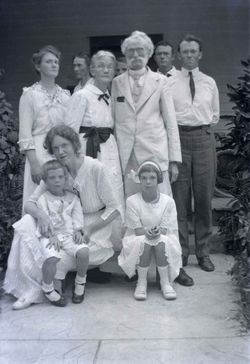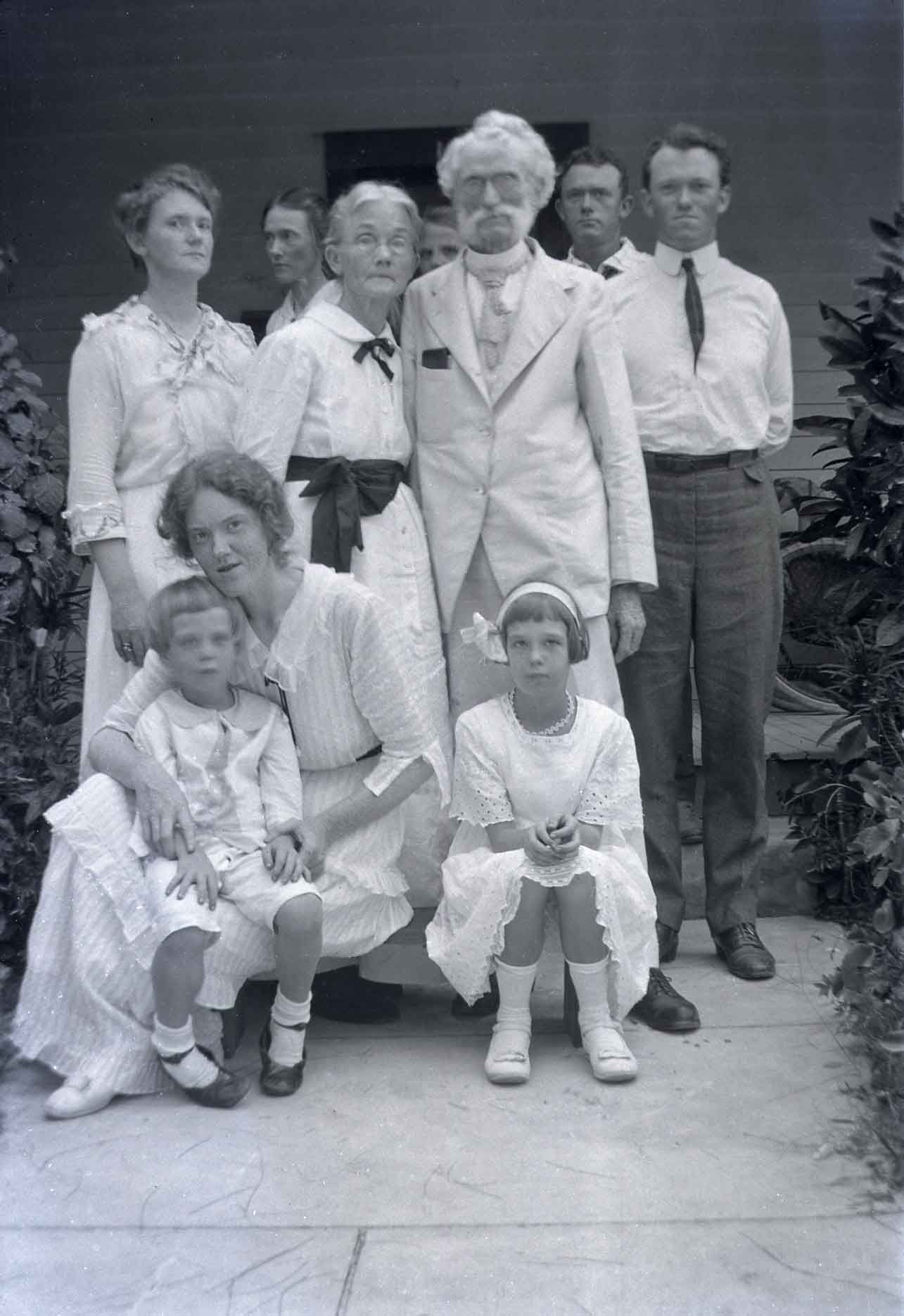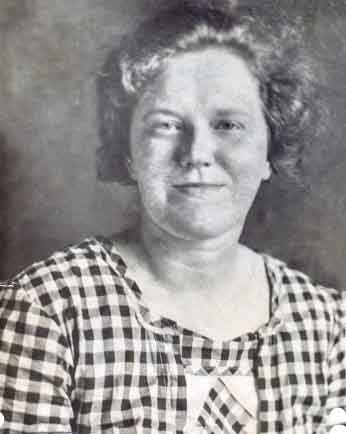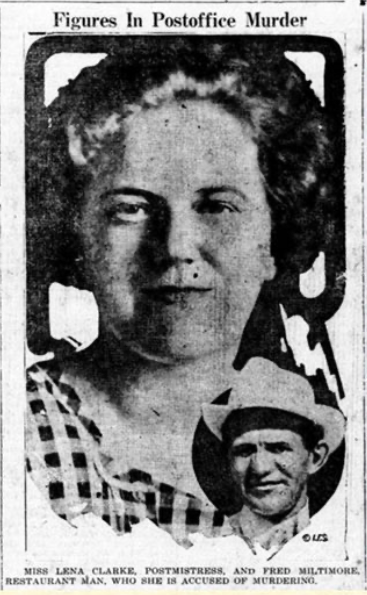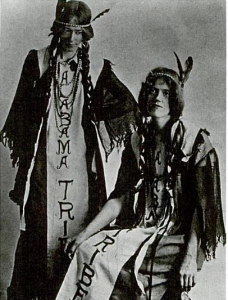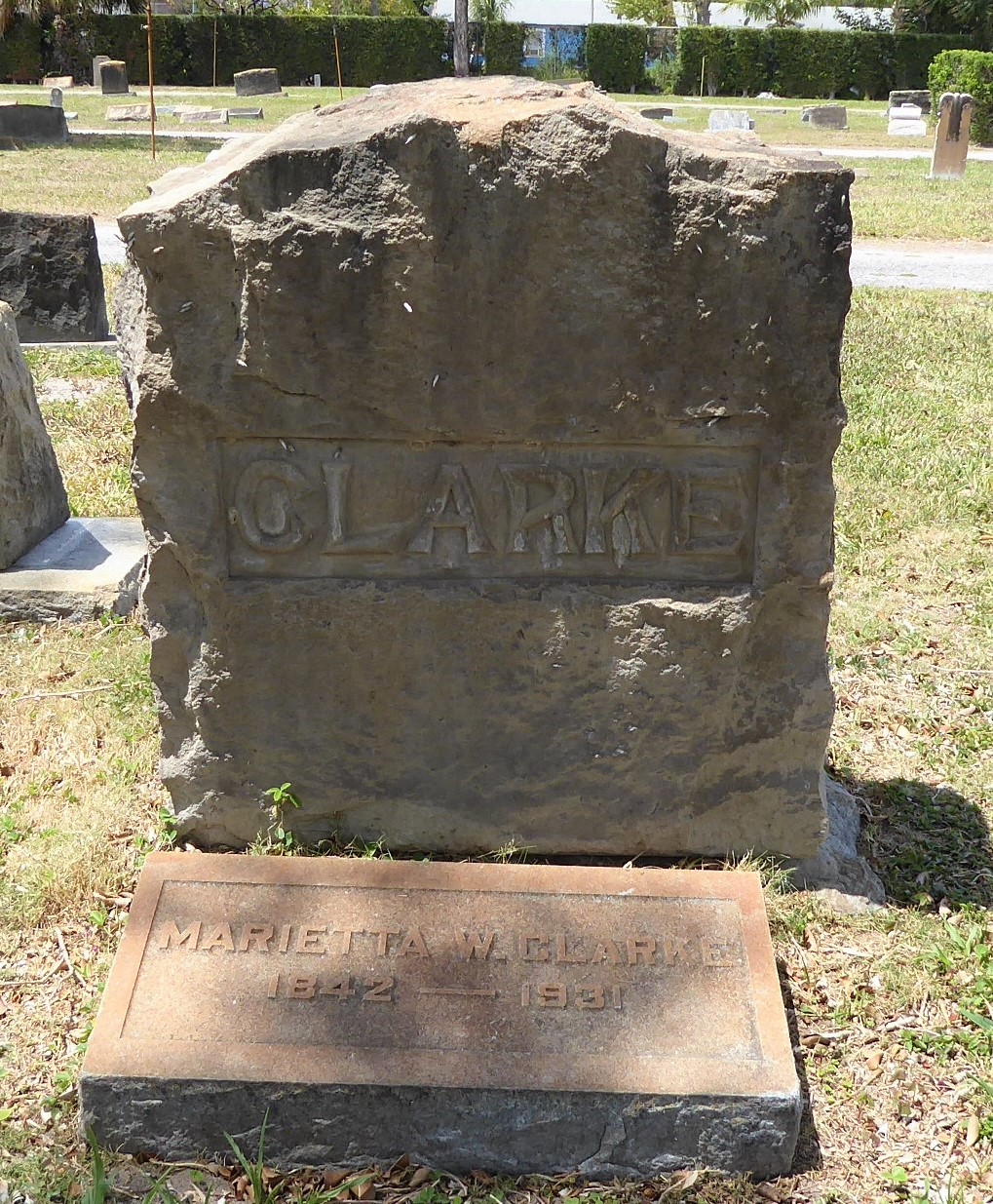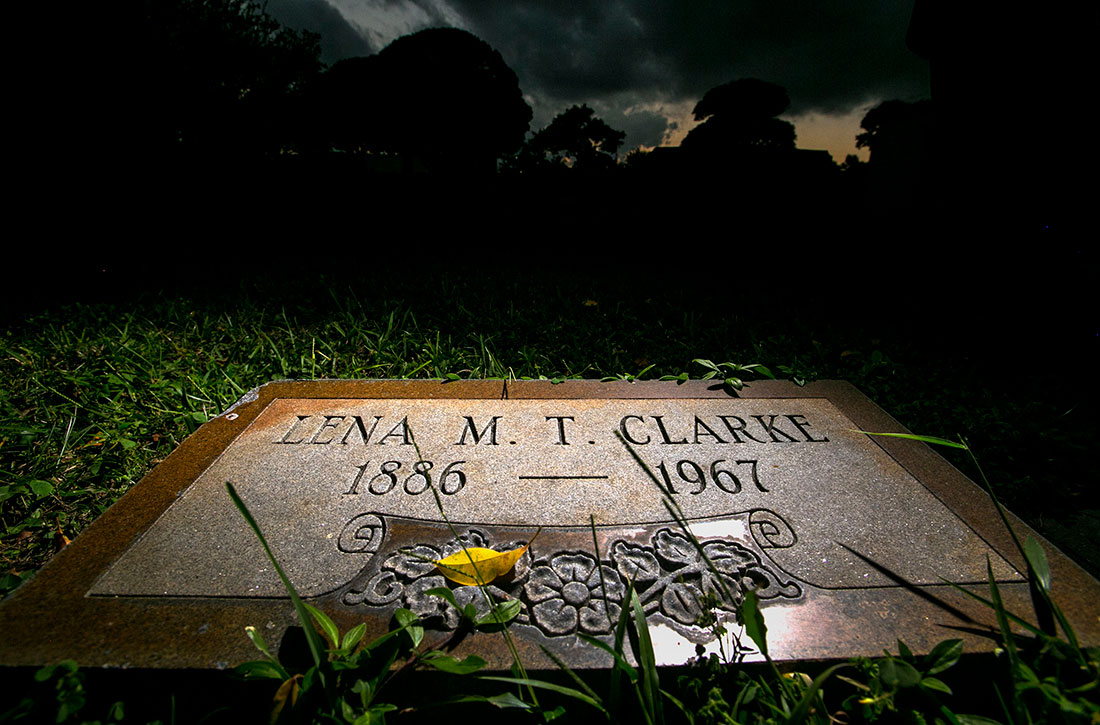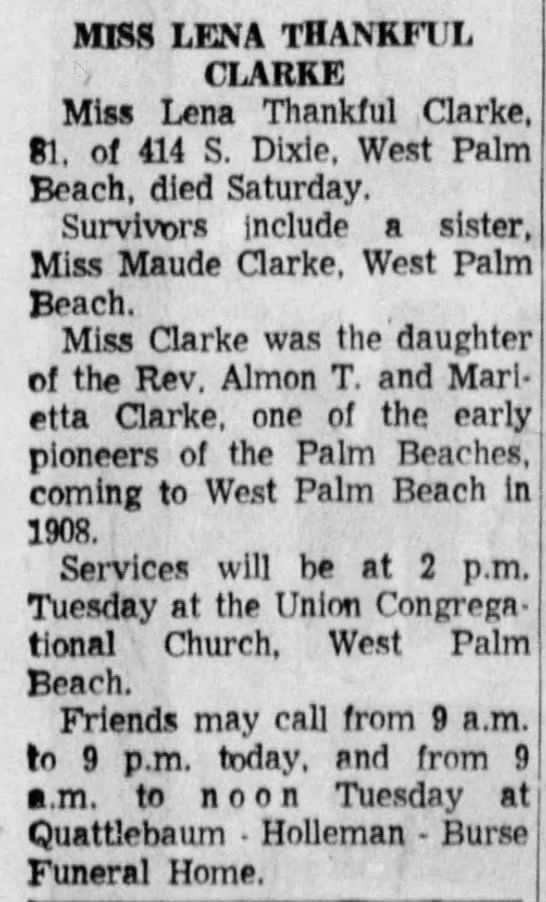Few of her friends or family knew the 35-year-old led a double life rife with occult dabblings, lavish spending and what The New York Times, in a front page story, called "many dubious relationships."
That summer, $32,000 was discovered missing from a registered mail sack. Suspicion centered on the new Postmistress. Clarke fled to Orlando with the law on her heels.
On a July night in her room at the luxury San Juan Hotel, she shot her former co-worker and married lover Fred A. Miltimore through the heart.
1921 newspaper photo of Lena Clarke and Fred A. Miltimore.
At first, she told police she only drugged him with morphine. Later, she confessed to the murder because Miltimore wouldn't take the rap for the theft.
"I did it after attempting to make him sign a statement that he had committed the robbery. He wouldn't sign and in desperation, I shot him," she told police.
The lurid tale of the flame-haired, unmarried Clarke became a sensational national story, even for the flamboyant 1920s. Newspapers of the day portrayed Prohibition-era West Palm Beach as a barely-civilized outpost, populated by Indians and rough-hewn settlers, fueled by illegal liquor and infested with dangerous animals. Writers called Clarke "a girl" and viciously described her appearance:
"Lena Mary Thankful Clarke, if you please, is a queer combination —a bundle of contradictions. In personal appearance and dress she is far from attractive. Her figure is heavy and uncorseted and her clothes smack of the backwoods.
"Her shoes are generally without heels and her stockings of cotton. Her skin is very fine in texture but covered with large, disfiguring freckles. Miss Clarke's only assets in appearance are her hair, which is decidedly Titian and naturally wavy, and her eyes, deep blue in color and absolutely straight and unwavering in their gaze," wrote newspaper writer Sue Pope.
In West Palm Beach, her friends and family were astonished at the revelations about their Postmistress' after-hours cavorting with men and alcohol. After all, her mother was a member of the Women's Christian Temperance Union and her father a retired minister.
"Knowing her tendencies to avoid society and taking into consideration that she could lay small claims to personal attractiveness, people have marvelled (sic) at the reported revelings in which whiskey played an important part," wrote the Washington Times.
Clarke wasn't the only wild one in her family.
The year before, her brother, John Paul, the former Postmaster, died of a snake bite.
John Paul was a snake and alligator collector (one newspaper called him a "snake charmer") as well as a prankster. He reportedly left snakes in post office boxes to scare patrons and in mailbags, one of the reasons Miltimore gave for moving to Orlando and becoming a restaurant manager.
"(Miltimore) said it was rather annoying at times to stick his hand into a mailbox and get a handful of rattlesnakes rather than letters," an acquaintance is quoted as saying in The New York Times.
On Christmas Day 1920, John Paul died from the bite of a coral snake, which had been a Christmas present from a local Seminole Indian. Some time later, leading local citizens signed a petition recommending Clarke for her brother's job.
After her arrest in Orlando, she at first confessed to the theft and murder, then recanted. She called herself a "superwoman" who could read the sheriff's mind.
In prison, awaiting trial, she wrote poetry. A portion of one poem called "A Fool's Wisdom" included the lines:
"I told you the course you pursued was wrong
But you laughed and said women are poor, weak fools.
So I hushed on my lips my life's merry song.
To pray, while disregarded God."
At her Orlando trial in November 1921, Clarke enthralled courtroom spectators by bringing her crystal ball to court. She spun tales of leading twelve previous lives. She was in the Garden of Eden when the solar system was created, she insisted. She also claimed to have been the Egyptian goddess Isis as well as the actress for whom William Shakespeare wrote the role of Ophelia.
On December 2, 1921, jurors acquitted Clarke by reason of insanity.
She spent two years at the Chattahoochee State Hospital for the Insane, then returned to West Palm Beach where she lived with her older sister, Maude, in downtown West Palm Beach.
She resumed her charitable activities and even taught Sunday School at the Congregational Church, where her father had been pastor. She died in 1967.
Neither sister ever married. Their small gravestones rest crookedly next to each other, sinking into Woodlawn Cemetery's patchy St. Augustine grass.
Clarke's saga in 1920 and 1921 has been memorialized in the 2023 book "The Crystal Ball Chronicles," a novel that tells the story of her double life, the theft and embezzlement from the post office, and the murder of Fred Miltimore. The book also details Lena's life after her furlough from Chattahoochie in 1924.
Few of her friends or family knew the 35-year-old led a double life rife with occult dabblings, lavish spending and what The New York Times, in a front page story, called "many dubious relationships."
That summer, $32,000 was discovered missing from a registered mail sack. Suspicion centered on the new Postmistress. Clarke fled to Orlando with the law on her heels.
On a July night in her room at the luxury San Juan Hotel, she shot her former co-worker and married lover Fred A. Miltimore through the heart.
1921 newspaper photo of Lena Clarke and Fred A. Miltimore.
At first, she told police she only drugged him with morphine. Later, she confessed to the murder because Miltimore wouldn't take the rap for the theft.
"I did it after attempting to make him sign a statement that he had committed the robbery. He wouldn't sign and in desperation, I shot him," she told police.
The lurid tale of the flame-haired, unmarried Clarke became a sensational national story, even for the flamboyant 1920s. Newspapers of the day portrayed Prohibition-era West Palm Beach as a barely-civilized outpost, populated by Indians and rough-hewn settlers, fueled by illegal liquor and infested with dangerous animals. Writers called Clarke "a girl" and viciously described her appearance:
"Lena Mary Thankful Clarke, if you please, is a queer combination —a bundle of contradictions. In personal appearance and dress she is far from attractive. Her figure is heavy and uncorseted and her clothes smack of the backwoods.
"Her shoes are generally without heels and her stockings of cotton. Her skin is very fine in texture but covered with large, disfiguring freckles. Miss Clarke's only assets in appearance are her hair, which is decidedly Titian and naturally wavy, and her eyes, deep blue in color and absolutely straight and unwavering in their gaze," wrote newspaper writer Sue Pope.
In West Palm Beach, her friends and family were astonished at the revelations about their Postmistress' after-hours cavorting with men and alcohol. After all, her mother was a member of the Women's Christian Temperance Union and her father a retired minister.
"Knowing her tendencies to avoid society and taking into consideration that she could lay small claims to personal attractiveness, people have marvelled (sic) at the reported revelings in which whiskey played an important part," wrote the Washington Times.
Clarke wasn't the only wild one in her family.
The year before, her brother, John Paul, the former Postmaster, died of a snake bite.
John Paul was a snake and alligator collector (one newspaper called him a "snake charmer") as well as a prankster. He reportedly left snakes in post office boxes to scare patrons and in mailbags, one of the reasons Miltimore gave for moving to Orlando and becoming a restaurant manager.
"(Miltimore) said it was rather annoying at times to stick his hand into a mailbox and get a handful of rattlesnakes rather than letters," an acquaintance is quoted as saying in The New York Times.
On Christmas Day 1920, John Paul died from the bite of a coral snake, which had been a Christmas present from a local Seminole Indian. Some time later, leading local citizens signed a petition recommending Clarke for her brother's job.
After her arrest in Orlando, she at first confessed to the theft and murder, then recanted. She called herself a "superwoman" who could read the sheriff's mind.
In prison, awaiting trial, she wrote poetry. A portion of one poem called "A Fool's Wisdom" included the lines:
"I told you the course you pursued was wrong
But you laughed and said women are poor, weak fools.
So I hushed on my lips my life's merry song.
To pray, while disregarded God."
At her Orlando trial in November 1921, Clarke enthralled courtroom spectators by bringing her crystal ball to court. She spun tales of leading twelve previous lives. She was in the Garden of Eden when the solar system was created, she insisted. She also claimed to have been the Egyptian goddess Isis as well as the actress for whom William Shakespeare wrote the role of Ophelia.
On December 2, 1921, jurors acquitted Clarke by reason of insanity.
She spent two years at the Chattahoochee State Hospital for the Insane, then returned to West Palm Beach where she lived with her older sister, Maude, in downtown West Palm Beach.
She resumed her charitable activities and even taught Sunday School at the Congregational Church, where her father had been pastor. She died in 1967.
Neither sister ever married. Their small gravestones rest crookedly next to each other, sinking into Woodlawn Cemetery's patchy St. Augustine grass.
Clarke's saga in 1920 and 1921 has been memorialized in the 2023 book "The Crystal Ball Chronicles," a novel that tells the story of her double life, the theft and embezzlement from the post office, and the murder of Fred Miltimore. The book also details Lena's life after her furlough from Chattahoochie in 1924.
Family Members
Sponsored by Ancestry
Advertisement
Records on Ancestry
Advertisement
